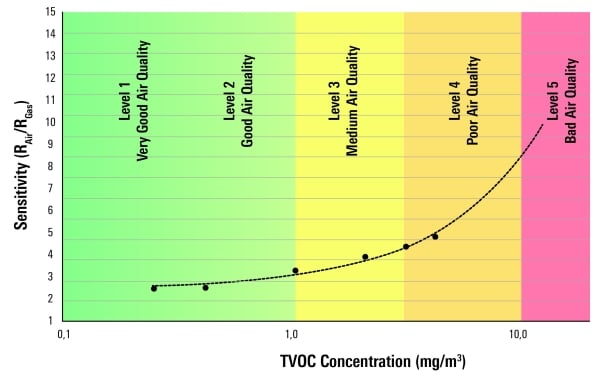The emergence of quantifying IAQ has finally crossed the chasm in the term coined by Geoffrey Moore in his book "Crossing the Chasm". Over the past several decades air quality measurement and management were limited to industrial applications. Pioneers in this space released products that were not always intuitive or lacked user understanding. The market was stuck in the preverbal chasm. With the shift from ceramic substrates to low cost and reliable silicon-based materials over the past 5 years, Metal Oxide (MOx) sensors have become digital, cost-effective, small, and reliable for consumer applications.
Barriers came primarily from the challenge of what is good versus bad air? Some aspects of IAQ were defined by the U.S. Environmental Protection Agency EPA and other organizations such as Formaldehyde and CO2 levels. Volatile Organic Compounds (VOC) are gasses found typically indoors that range from mild irritants to carcinogens and were not defined relative to the impacts on our health. These VOC’s that are not always detected from smell are generated from furniture, building materials, cleaners, cooking, and bathroom emissions. The first recognized definition of IAQ based on Total Volatile Organic Compounds (TVOC) came from the German Environmental agency’s Umweltbundesamt study (UBA) with their released reports. The UBA definition considered work done by various global governmental agencies and then classified air quality in 5 groups with a suggested time that an individual should be in this environment to avoid health issues. This was the initial definition that several sensor companies adopted to calibrate their absolute measurements and report a scale. Over the past couple of years, partially due to COVID and the interest in air quality, other organizations have been active in defining air quality standards. The WELL organization has released indoor air quality definitions in North America with SEMI developing standards and ASHRAE related groups considering TVOC recommendations. RESET has been working on a common definition in Asia and in Europe UBA has been released with VDI working towards air quality standards that consumers can understand and be confident that they are in healthy air. These same definitions will be used by HVAC systems to ensure our air quality is adequate in both homes and commercial buildings.
MOx sensors have now advanced to reliably measure TVOC and report air quality based on known concentrations and the impact on our health according to the above defined standards. This is derived from sensors that provide an absolute output. Other sensors on the market provide a relative output that is not useful in standards-based reporting. The absolute measurement comes from sensors establishing a baseline and managing this through algorithms taking many factors into consideration, as well as calibration coefficients stored in non-volatile memory.
With the culmination of low cost sensors, firmware configurable devices, absolute output of sensors and a defined air quality definition; we are seeing monitoring devices and systems moving into the mainstream. Consumers will demand standards-based reporting of systems and as in the the Crossing the Chasm defined the market, we have now moved into an "early Majority" position in 2022.
Consumers and healthy air are the clear winners.

